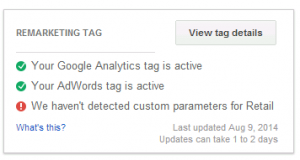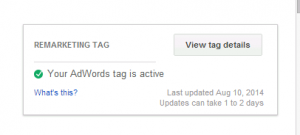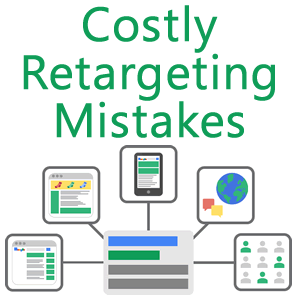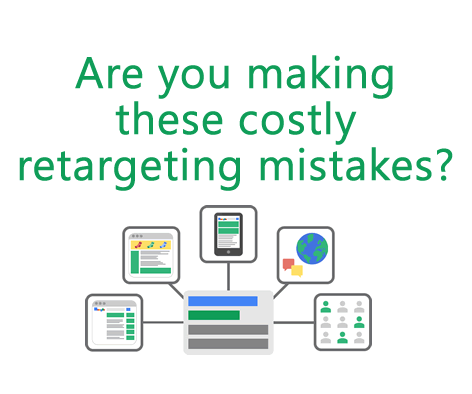When I audit Adwords accounts, I often see accounts where there are still no remarketing campaigns. For others, I see an old remarketing campaign that somebody “tested” at some point and was then turned off due to poor success metrics or very low volume. Most commonly, I see accounts running remarketing, and though the metrics are “okay”, they are not nearly as good as they could be and the activity is very small relative to the advertisers search spend.
The problem with mediocre remarketing campaigns is that people complacently tend to discount the “remarketing channel” when, in fact many remarketing campaigns are suffering from poor execution and are not producing volume or results like they could with a few best practices applied.
Here are the 6 biggest mistakes you should avoid (or correct) for your remarketing campaigns:
Not Everything is Tagged
Make sure that your remarketing pixel is on every page of your site. This includes the “logged in” portion of your site (we’ll get to why later) , your mobile site (If the pages are different than your desktop), the thank you page and if you have a blog or content area of your site, tag that too. If you have a YouTube channel, connect your account to your Adwords account to collect your subscriber and video views as remarketing audiences.
If you are a retailer, make sure to update your remarketing code to facilitate dynamic remarketing. This can be a bit more “heavy lifting”, but product-level dynamic remarketing ads pay off for most ecommerce sites.

Not sure what pages are actually tagged? To see what pages are generating your remarketing audiences, on your audience tab click “View Tab Details” on the top right

Then click on “Your Adword Tag is Active” in the details tab and you’ll be able to see a list of the top 10 URLs that are tagged with your remarketing pixel.
Scroll down to the bottom and you can download a list of your top 500 URLs. Use this to verify that important pages are not missing the remarketing pixel. Orphaned landing pages (where much search traffic is sent) often are pages where somebody forgot to put the remarketing pixel. You may find the mobile site isn’t tagged. Often, low impressions or lackluster remarketing performance is simply due to the fact that the pixel isn’t actually collecting all the users that it should.
No Audience Exclusions
This is where tagging the logged-in part of your site is handy. If you have already “acquired” a user, you probably want to exclude them from new acquisitions remarketing. Create audiences for your converted users and exclude them from your remarketing campaigns.
If you are in lead gen, you want to exclude people who have been to your thank you page and are in your nurturing funnel.In ecommerce, you may want to target your converted purchasers with an accessory product or offer seasonal discounts down the road, however, for some period of time after conversion, most retailers should probably leave the customer alone for a little while. The audience you exclude from your remarketing will vary by business but almost all businesses have some visitors that don’t belong in your remarketing audience. The campaign exclusions section can be found on your display tab, Interests and remarketing sub tab, down at the bottom left.
Additionally, exclude your “all visitors” audience from your non-remarketing GDN campaigns. This will keep your reporting “clean” for performance on both segments of users and ensure your impression caps are adhered to on both as well. The efforts here will likely increase your CTR by eliminating less valuable impressions. In turn, Google will begin serving more impressions on your campaigns with a lower CPC.
No Impression Caps
Speaking of limiting less-valuable impressions, most people neglect to put an impression cap on their remarketing campaigns. I recently created a remarketing group for an audience of 35,000 – Google shows this has potential reach of 15M-20M impression per week. At 15M impressions I’d be serving each person 428 times. Think they might get annoyed?
The Wrong Type of Ads
I’m not even talking about the messaging in the ads, although that can be a big key to success. For this purpose, I’m simply talking about the type of ad. Many people only use banner ads in their remarketing, but text ads can be very effective too. You should separate your ad groups for each type of ad as performance and placements on which they appear tend to be different. Then, you can optimize to the performance of each ad type.
Another ad type problem I see is flash ads. There must have been some article at some time that encouraged people to use flash-based remarketing ads because I’ve audited several accounts that only had flash ads in their remarketing campaigns. Testing flash ads is great. However, Google allows large publishers to opt-out of showing flash ads, so you could severely be limiting your reach unless you also have static ads to serve. Here’s what happened to a campaign with just flash ads when we added static ads to their remarketing campaigns as well.
The Bids Are Too Low
Because Google prices on eCPM reason, getting traction and impressions for a small audience (most remarketing campaigns are) can be difficult. Lots of deep-pocket advertisers are vying for those same eyeballs in a myriad of ways.
If you start with high bids, the algorithm will see quickly that your CTR and overall performance is high relative to others competing for the impressions (almost always true with remarketing campaigns).Then, you can step down your bid while retaining a nice impression share after the campaign has gathered some data.
Alternately, once you push through 15 conversions, you can switch to CPA bidding to control your costs.If you never give the system a high enough bid to start giving you your premium remarketing impressions, you’ll only get the trickle of less competitive impressions on non-premium placements.
It’s Not Actually Remarketing
There are several “gotchas” when setting up remarketing campaigns that can mean that you aren’t exactly targeting your remarketing audience.
One is that when setting up a remarketing campaign, Google defaults to having the “Conservative Targeting Optimization “ button checked. You need to uncheck this or Google may be serving ads to users that that haven’t actually been to your site.
You should absolutely test similar users audiences, but do so in a separate campaign with its own budgets and creative and let your remarketing campaign be true remarketing.
I’ve also seen several accounts where a remarketing campaign was set up, then never gets a single impression. This is typically because the “flexible reach” settings for the adgroups are set to “bid only” for interests and remarketing. You need it set to “bid and target” for the system to view your selected audience as a targeting type. This can be switched easily in Adwords Editor on the ad group tab in the “flexible reach” section.
Remarketing is a powerful tool and can be a source of significant conversion volume with metrics as good as, or better than, your search campaigns. Make sure you set your campaigns up to succeed and do not discount the channel until you are certain that you are actually reaching the right audience, not getting on their nerves and eliminating impressions that are unlikely to lead to clicks and conversions. Once your targeting is “tight”, bid high enough to get the engine humming and let the algorithmic benefits of high CTR on this pre-qualified audience lead to high quality impression volume and high-quality conversions at scale for your business.
From there, enjoy the success, but remember that even if the metrics are good, just like any other GDN effort, they can be optimized and made better. Scheduling, placement exclusions, new creative, bid modifiers on device, age, gender and parental status; all the things you do to optimize your “regular” GDN campaigns, should also be regularly executed on your remarketing campaigns to drive continuous improvement.
Susan Waldes
Latest posts by Susan Waldes (see all)
- Upgraded Adwords Reporting Rolling Out to Accounts - April 17, 2015
- View-Through Conversions For GDN Text Ads Rolling Out? - February 10, 2015
- Less Editorial Delays: AdWords Releasing “Upgraded URLs” - February 6, 2015
- Display Select GDN Keyword Targeting Spotted in Google AdWords Accounts - December 5, 2014
- Shared Business Data: Data Feeds Come to Adwords Ads - September 23, 2014

